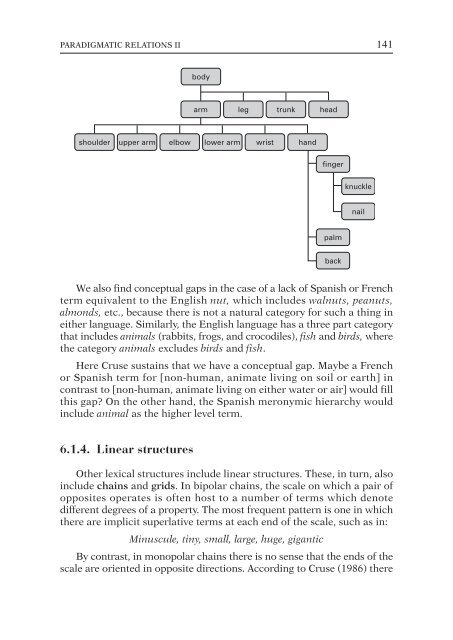Semantics
You also want an ePaper? Increase the reach of your titles
YUMPU automatically turns print PDFs into web optimized ePapers that Google loves.
PARADIGMATIC RELATIONS II 141<br />
body<br />
arm leg trunk head<br />
shoulder<br />
upper arm<br />
elbow<br />
lower arm<br />
wrist<br />
hand<br />
finger<br />
knuckle<br />
nail<br />
palm<br />
back<br />
We also find conceptual gaps in the case of a lack of Spanish or French<br />
term equivalent to the English nut, which includes walnuts, peanuts,<br />
almonds, etc., because there is not a natural category for such a thing in<br />
either language. Similarly, the English language has a three part category<br />
that includes animals (rabbits, frogs, and crocodiles), fish and birds, where<br />
the category animals excludes birds and fish.<br />
Here Cruse sustains that we have a conceptual gap. Maybe a French<br />
or Spanish term for [non-human, animate living on soil or earth] in<br />
contrast to [non-human, animate living on either water or air] would fill<br />
this gap? On the other hand, the Spanish meronymic hierarchy would<br />
include animal as the higher level term.<br />
6.1.4. Linear structures<br />
Other lexical structures include linear structures. These, in turn, also<br />
include chains and grids. In bipolar chains, the scale on which a pair of<br />
opposites operates is often host to a number of terms which denote<br />
different degrees of a property. The most frequent pattern is one in which<br />
there are implicit superlative terms at each end of the scale, such as in:<br />
Minuscule, tiny, small, large, huge, gigantic<br />
By contrast, in monopolar chains there is no sense that the ends of the<br />
scale are oriented in opposite directions. According to Cruse (1986) there



